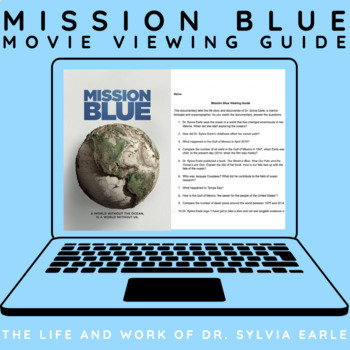Mission Blue (Netflix Documentary) Movie Viewing Guide
- Google Docs™

What educators are saying
Description
This product is a viewing guide to the Netflix documentary movie “Mission Blue” about the life and work of Dr. Sylvia Earle, an oceanographer and marine biologist. The viewing guide is 30 questions: some are fill in the blank, some are short short answer questions asking students to record significant statistics from the documentary, reason cause and effect, or relationships between concepts elaborated in the film. Use this worksheet in your Earth or Environmental Science or Ocean/Marine Science class to keep students engaged and paying attention throughout the movie. This movie is great to use in conjunction with topics such as about the ocean, aquatic pollution, ecosystems, overfishing, coral reefs, and climate change and is appropriate for students ranging from middle school to high school age. This document can be printed and used for in-person class or distributed digitally for online learning, in a synchronous or asynchronous lesson. An answer key is provided for teacher use.
EnvironmentLA has more movie viewing guides:
- David Attenborough: A Life on Our Planet Viewing Guide (about the impact of climate change on ecology of the Earth)
- From the Ashes Viewing Guide (about the coal industry in the United States)
- Raging Planet: Lightning Viewing Guide (about the causes and effects of thunder and lightning storms)
- My Octopus Teacher Viewing Guide (about kelp forest ecosystems and one diver's relationship with an octopus!)
- Kiss the Ground Viewing Guide (about soil and climate change)
- Brave Blue World (about the global water crisis)
- Cowspiracy Viewing Guide (about agriculture and climate change)
- Food Evolution Viewing Guide (about genetically modified organisms, GMOs)
Any requests for future movie viewing guides? Message us!



